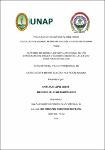Factores de riesgo y estado nutricional de los estudiantes de primer y segundo grado de la I.E.P.M. N°60039 Tamshiyacu 2019

View/
Date
2021Author
Lopez Cobos, Anita Rubi
Ocampo Acho, Mercedes del Pilar
Metadata
Show full item recordAbstract
The present investigation was to determine the risk factors involved in the nutritional status of first and second grade children of the I.E.P.M N ° 60039 Tamshiyacu. The research is non-experimental, descriptive, correlational, cross-sectional; the sample was of 144 schoolchildren; Instruments such as a food consumption frequency survey were used; nutritional evaluation file, physical activity survey, and socio-economic level survey; nutritional status was determined by BMI / E, T / E. It was found that 76% have normal height / age, 14% short height, and 10% tall height, likewise 60% have a normal BMI / Age, 23% are overweight, and 17% are obese; 15% present unhealthy habits, 44% adequate or sufficient, and 41% healthy habits; 10% of those evaluated have a low frequency of food consumption, 24% average, and 66% a high consumption of healthy foods; for physical activity, 1% have a high level, 38% a normal level, 60% a low level, and 2% a very low level; 47% of those evaluated have a low socioeconomic level, 36% a medium level, and 16% a high level; There is a positive relationship of very low height / age level and eating habits, frequency of food consumption, physical activity and socio-economic level with a value of bilateral significance (p = 0.02; 0.041; 0.029; and 0.046) with Rho Spearman's (0.253, 0.066, 0.117 and 0.086); Likewise, there is a positive relationship of very low level of BMI / Age and eating habits, frequency of food consumption, level of physical activity, and socioeconomic level, with a confidence level of 95%, it is said, that for height / age and eating habits, frequency of food consumption, physical activity, and socioeconomic level with value of bilateral significance (p = 0.031, 0.044, 0.012, and 0.018) with Spearman's Rho (0.129, 0.121, 0.278 and 0.120). La presente investigación determinó los factores de riesgo que intervienen en el estado nutricional de niños de primer y segundo grado de la I.E.P.M N°60039 Tamshiyacu. La investigacion fue no experimental, descriptivo correlacional, de corte transversal; y una muestra de 144 escolares; los instrumentos utilizados fueron la encuesta de frecuencia de consumo de alimentos, ficha de evaluacion nutricional, encuesta de actividad física, y encuesta de nivelsocieconómico; el estado nutricional fue determinado mediante el IMC/E, T/E. Se encontraron que el 76% tiene talla/edad normal, el 14% talla baja, y el 10% talla alta, asimismo el 60% tiene un IMC/Edad normal, un 23% con sobrepeso, y un 17% con obesidad; 15% presentan hábitos no saludables, 44% adecuados o suficientes, y 41% hábitos saludables; 10% de los evaluados tienen una frecuencia baja de consumo de alimentos, 24% medio, y 66% un alto consumo de alimentos saludables; para actividad física el 1% tiene un nivel alto, 38% un nivel normal, 60% un nivel bajo, y 2% un nivel muy bajo; 47% de los evaluados tienen un nivel socioeconómico bajo, 36% un nivel medio, y 16% un nivel alto; Existe una relación positiva de nivel muy bajo de talla/edad y los hábito alimentarios, frecuencia de consumo de alimentos, actividad física y nivel socio económico con valor de significancia bilateral (p = 0,02; 0,041; 0,029; y 0,046) con Rho de Spearman (0,253; 0,066; 0,117 y 0,086); asimismo existe una relación positiva de nivel muy baja del IMC/Edad y los hábitos alimentarios, frecuencia de consumo de alimentos, nivel de actividad física, y nivel socioeconómico, con un nivel de confianza de 95%, a diferencia que para la talla/edad y los hábitos alimentarios, frecuencia de consumo de alimentos, actividad física, y nivel socioeconómico con valor de significancia bilateral (p = 0,031; 0,044; 0,012; y 0,018) con Rho de Spearman (0,129; 0,121; 0,278 y 0,120).
Collections
- Tesis [189]

